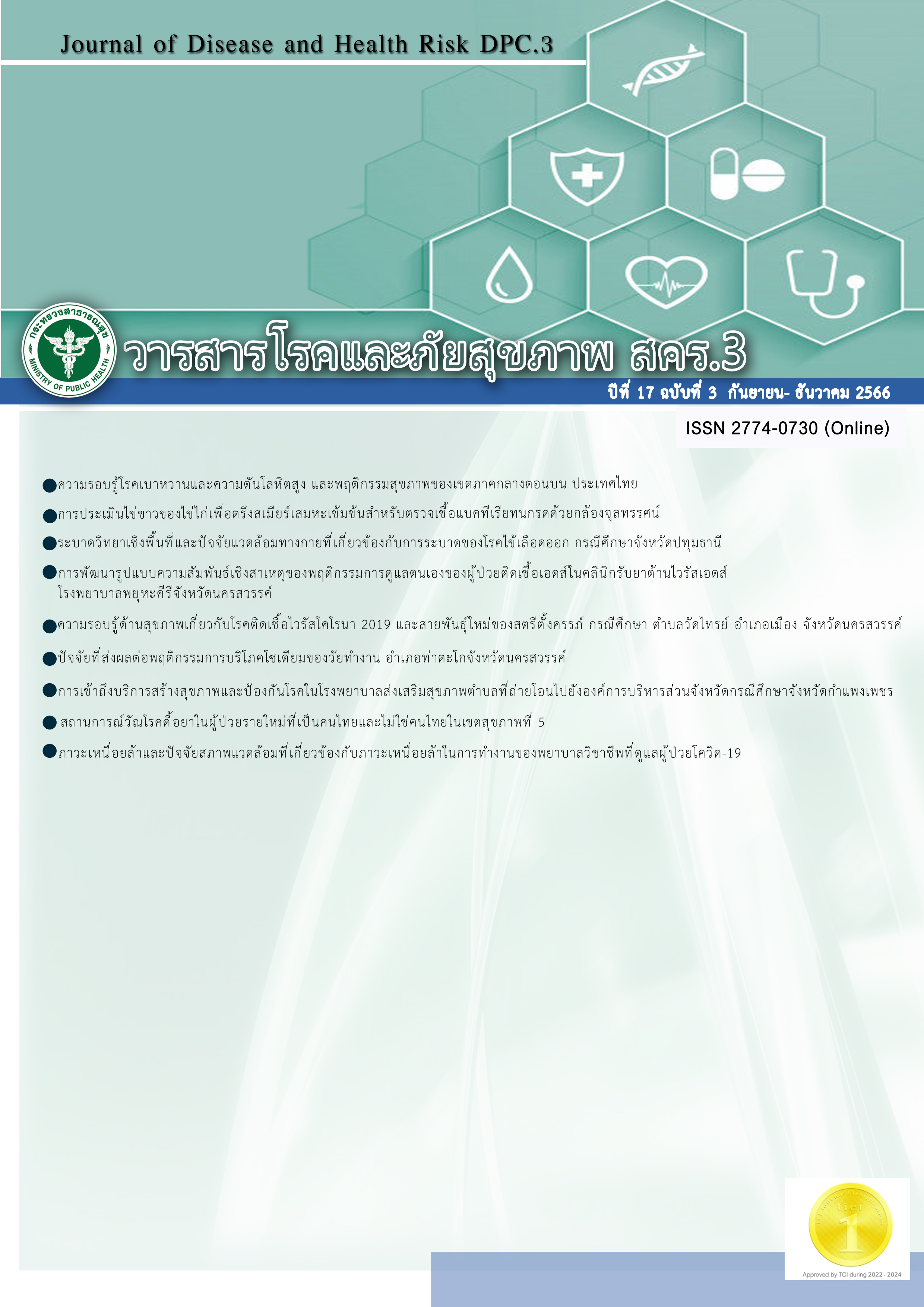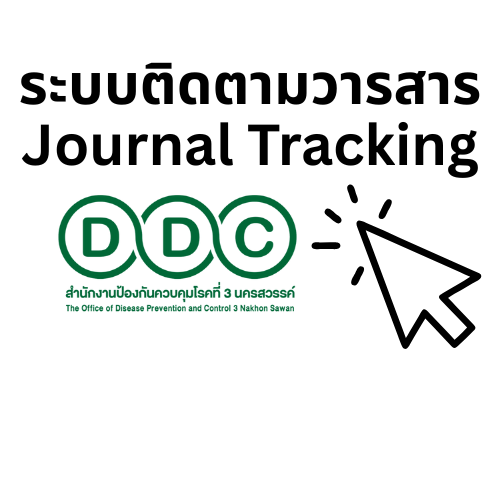Spatial Epidemiology and Physical Environmental Factors Related to Dengue Fever Outbreak: A Case Study in Pathum Thani Province
Keywords:
Spatial Epidemiology, Dengue Fever, Physical Environmental FactorsAbstract
This study aimed to determine the spatial distribution and physical environment factors related to dengue risk in Pathum Thani province. We performed a Retrospective cohort study of Dengue fever patients between December 2019 and December 2020 from the R506 program. Secondary data was retrieved from the Provincial Public Health Office, Office of Disease Prevention and Control, and Meteorological Department. Statistical analyses were using Poisson regression. Results showed that there were 429 patients with dengue fever, consisting of 226 men (52.68%) and 203 women (47.32%). While classified by age group, we found that most were in the range of 6-18 years, 48.95%. The mean age was 22.76±17.08 years old. Occupations with the highest number of cases were students (53.85%). Distribution of patients with dengue was seen in all areas of the Pathum Thani province. Factors associated with dengue fever in Pathum Thani Province from December 2019 to December 2020 were mosquito larvae (house index: HI) the incidence rate ratio (IRR) was 1.03,(95 % CI: 1.01-1.06) and when analyzing the retrospective data After 10 years (2010-2019), the factors related to the dengue fever rate were the risk scores IRR = 2.15, (95% CI: 1.85-2.51) and no relationship with environmental factors such as mosquito larvae index, temperature, relative humidity, rainfall, and population density were found. Dengue fever surveillance in densely populated urban areas requires strict measures for implementation. Scholl should set up dengue surveillance measures and educate students to prevent dengue fever
References
Department of Disease Control. Urban Dengue Unit Guideline. Bangkok: The agricultural Co-operative Federation of Thailand; 2018. (in Thai)
Pediatric Infectious Disease Society of Thailand. Advice to the public regarding the use of the dengue fever vaccine as a tool for disease prevention and control in Thailand. [Internet]. [cited 2019 December 20] Available from https://www.pidst.or.th/A580.html
Koranat Chune, Warangkana Chankong, Theerawut Thammakun. Factors AffectingthePerformance of Problem-SolvingDengue Haemorrhagic Fever of Personnel Sub –district Health Promoting Hospital in Redundant Epidemic Areas, Nakhon Si Thammarat Province. TJPHS 2022; Vol.5 No.1: page 93-106 (in Thai)
Ministry of public health. MOU Cooperation in Environmental Management to Control Aedes Aedes Mosquitoes, No. 3, Year 2019-2023. [Internet]. 2019. [cited 2019 December 26] Available from https://www.chanthaburi.go.th/newsdepartment/detail/22.
Usawadi Thawara.(Mosquito vectors). In: Usawadi Thawara, Chakkawan Chomphusri, Suwattana Siri-on, Sukanya Purothakanon, editors. Biology and control of insects that are a public health problem. 4th ed. Bangkok: D-ONE BOOKS; 2553. p. 1-24. (in Thai)
Pathum Thani Provincial Health Office. (2019,20 November). Report on mosquito sensitivity to chemicals Guidelines for chemical resistance management and criteria to support spraying of aerosol chemicals on cars. No 0032/8494 On 20 November 2019. (in Thai)
Division of Vector Borne Diseases. Dengue fever situation Report, week 50. [Internet]. 2019. [cited 2019 December 20] Available from https://drive.google.com/drive/folders/1TTaSvaYYamVwA5Ig7ATZJmIcHBuGXOSb.
Division of Vector Borne Diseases. Dengue fever forecast report for the year 2020. [Internet].2020. [cited 2020 June 18] Available from https://ddc.moph.go.th/thaivbd.
The office of disease prevention and control 6 Chonburi. Forecast of areas at risk for dengue fever in the eastern region in 2012. 2012.
Suangsuda Kongmang. Application of Geographic Information System. For epidemiological surveillance. Built Environment Inquiry, 9(1), 76–89. (in Thai)
Withanage GP., Gunawardana M., Viswakula SD., Samaraweera K., Gunawardena NS., Hapugoda MD.,Multivariate spatio-temporal approach to identify vulnerable localities in dengue risk areas using Geographic Information System (GIS). Sci Rep. 2021;11(1):4080.
Pathum Thani Provincial Health Office. Epidemiological surveillance report for December 2019. 2019.
Winai Panoan. Knowledge and skill in preventing and controlling dengue hemorrhagic fever ot health volunteer in Pai District, Maehongson Province. Ganesha journal 2019; 15(2): 149-59. (in Thai)
Kanchana Youngkhao, Kanyarat Sa Kaeo. Dengue hemorrhagic fever forecasted by 5 dimension dart user in 9th Regional Health Area,2015. Disease control journal Volume 49 No. 3 July-September 2023. (in Thai)
Zambrano LI, Rodriguez E, Espinoza-Salvado IA, Fuentes-Barahona IC, Lyra de Oliveira T, Luciano da Veiga G, et al. Spatial distribution of dengue in Honduras during 2016-2019 using a geographic information systems (GIS)-Dengue epidemic implications for public health and travel medicine. Travel Med Infect Dis. 2019;10151: 1-10.
Anderson DJ, Rojas LF, Watson S, Knelson LP, Pruitt S, Lewis SS, Sexton DJ; CDC Prevention Epicenters Program. Identification of novel risk factors for community-acquired Clostridium difficile infection using spatial statistics and geographic information system analyses. PLoS One. 2017 May 16;12(5):e0176285. doi: 10.1371/journal.pone.0176285. PMID: 28510584; PMCID: PMC5433765.
Chanchainarong Songkasri. Model Forecasting of Dengue Haemorrhagic Fever Diseases in Office of Diseases Prevention and Control 6 Khonkaen Province,2012. Journal The Office of Diseases Prevention and Control 6 Khonkaen 2013; 20(1): 65-81. (in Thai)
Warang Noisukserm. The Geographic Information System for Dengue Haemorrhagic Fever Surveillance in Bangkok Metropolis. Koch Cha Sarn Journal of Science 2017; 39(1): 23-37. (in Thai)
Worawit Tidthian, Thawisak Thongbu, Usarad Tidthian. Risk factors of dengue fever affecting the determination of risk areas at the sub-district level of the Health. Journal of disease prevention and control: DPC.2 Phitsanulok 2021;8(1):56-68. (in Thai)
Zainab N., Tariq A.,Siddiqui S.. Development of Web-Based GIS Alert System for Informing Environmental Risk of Dengue Infections in Major Cities of Pakistan. Geosfera Indonesia 2021;6(1):77-96.
Siddiq A, Shukla N, Pradhan B. Predicting dengue fever transmission using machine learning methods. IEEE International Conference on Industrial Engineering and Engineering Management (IEEM); 2021 Dec 13-16; Singapore, Singapore; 2021. p. 21-6.
Oraya Preechapanich , Suda Thernmontri. A Geographic Information System for Supporting the Surveillance of Dengue Infection in Songkhla Province. Thaksin.J 2015;18(3): 161-69. (in Thai)
Jaturong Somard, Savittri Ratanopad Suwanlee, Niruwan Turnbull, Tammanoon Phommat. Analyzing dengue fever risk areas using geographic information systems in Dome Pradis Sub-district, Nam Yuen District, Ubon Ratchathani Province. J Med Health Sci 2017;24(3): 65-76.
Downloads
Published
How to Cite
Issue
Section
License
Copyright (c) 2023 Journal of Disease and Health Risk DPC.3

This work is licensed under a Creative Commons Attribution-NonCommercial-NoDerivatives 4.0 International License.
Copyright notice
Article published in the Journal of Disease and Health Risk DPC.3 Nakhon Sawan. It is considered a work of academic research and analysis as well as the personal opinion of the author. It is not the opinion of the Office of Disease Prevention and Control 3, Nakhon Sawan. Or the editorial team in any way Authors are responsible for their articles.
Privacy Policy
Name, address and e-mail address specified in the Journal of Disease and Health Risk DPC.3 Nakhon Sawan. It is used for identification purposes of the journal. And will not be used for any other purpose. Or to another person.









